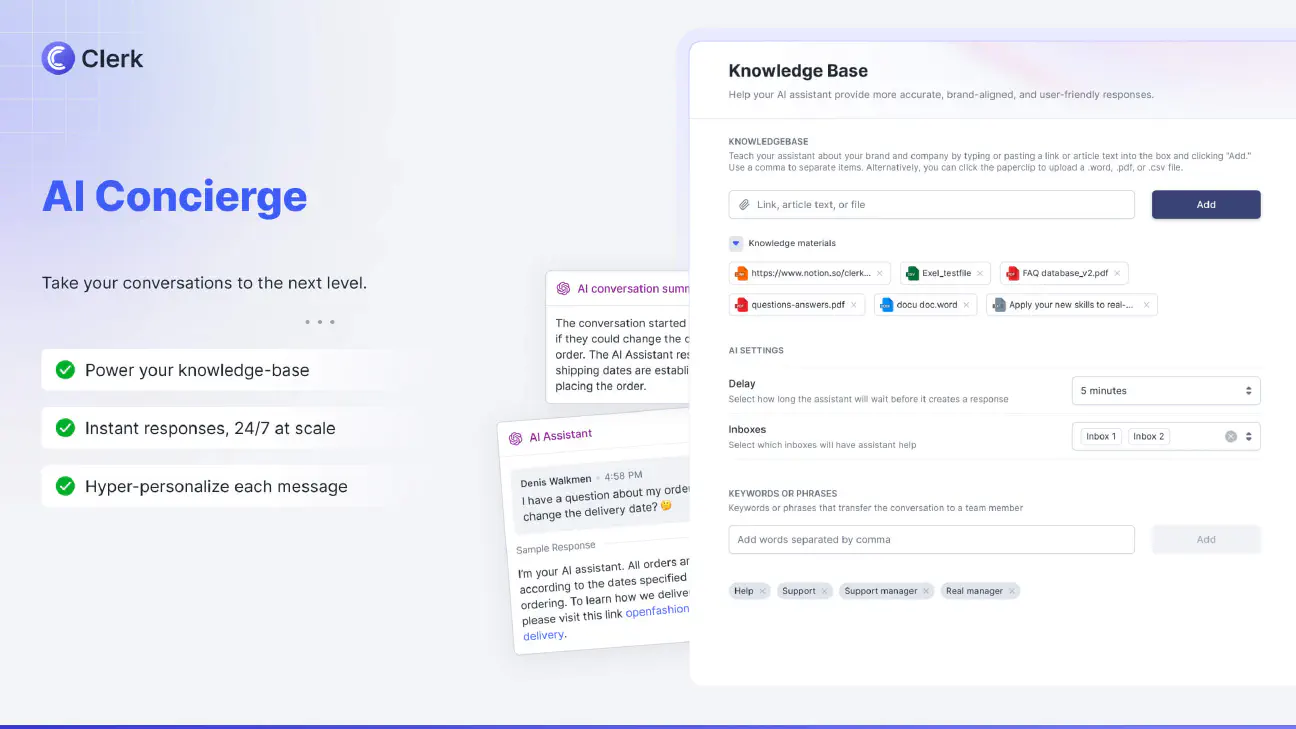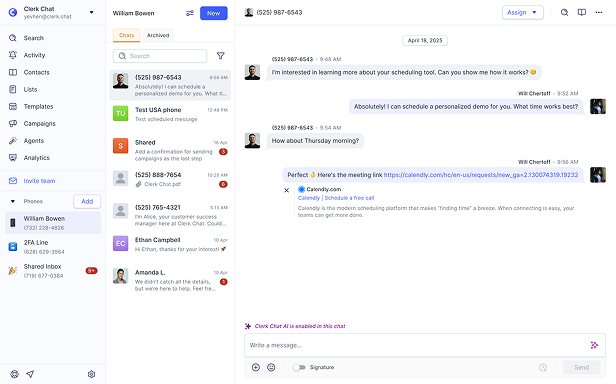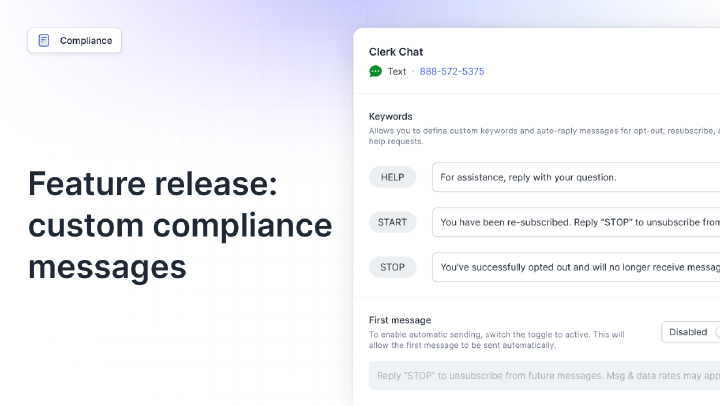Conversational AI vs Chatbot: What’s the Difference?
By Team Clerk Chat
- Published: June 28, 2024
Conversational AI vs Chatbot: what’s the difference?
In today’s digital era, where companies are relying on artificial intelligence for everything from marketing automation, to customer service and productivity enhancements, the two terms are often used interchangeably. However, there is a difference.
For instance, though conversational AI is used to power many modern chatbots, such as finance AI chatbot tools and virtual assistants, not every chatbot features conversational AI functionality.
In fact, some chatbots don’t even leverage AI.
Confused? Don’t worry. Here, we’ll share everything you need to know about conversational AI, and chatbots, so you can decide what your business really needs.
Conversational AI vs Chatbot: The Quick Overview
If you’re looking for a quick TLDR definition, a chatbot is a software solution capable of simulating human-like conversations with customers.
For instance, an AI chatbot for banks could allow customers to instantly access information about their accounts, products, and interest rates, through a messaging app or website.
Conversational AI, on the other hand, is a broader technology that enables computers to simulate conversations leveraging advanced algorithms, such as natural language processing and machine learning. While chatbots operate according to predesigned conversation flows, or use AI to identify customer intent and provide answers, conversational AI uses different methods.
Conversational AI solutions, like the Clerk AI assistant, collect and analyze data with natural language processing, facilitating a more personalized experience.
Conversational AI can also power a range of other solutions other than AI chatbots, such as IVR systems in the contact center, analytical tools, and smart speakers.
Let’s break things down a little further.
Learn how to create conversations that convert - with SMS
Book a free, personalized product tour to see our user-friendly interface, discover our most-used features, and get answers to your questions
Conversational AI vs Chatbot: What is a Chatbot?
Chatbots are computer programs that simulate conversations with users. You’ll find them on websites, offering 24/7 customer service, built into mobile apps, and implemented into transactional SMS strategies in some cases.
Chatbots are one of the most popular tools in the modern customer experience and communication landscape. In fact, by 2032, the chatbot market is expected to be worth around $32.4 billion.
However, in today’s world, chatbots come in different forms. Most commonly, they’re divided into rule-based chatbots and AI chatbots.
Rule-based chatbot vs AI chatbot
The disconnect between AI vs bot solutions can be difficult to understand. We often assume all chatbots are AI-powered, but this isn’t always the case. A lot of traditional bots, known as rule-based chatbots, don’t use artificial intelligence.
Instead, they deliver automated messaging responses to customers using pre-built workflows. For instance, if you message the “HubBot” bot on HubSpot’s website, it will use the words you enter into your message to define an appropriate response, based on the data it has access to.
Under the hood, rules-based bots use simple decision trees to support customers. If you say something like “tell me about my account balance,” it will check this tree to figure out how to respond.
AI chatbots, on the other hand, use elements of conversational AI to interpret user inputs more effectively. They leverage natural language understanding and machine learning to interpret the intent behind your messages, and deliver a personalized response.
For example, an accounting AI bot might use data from previous interactions with other customers and data about a specific customer to deliver personalized investing advice. Some modern solutions even use generative AI to create unique, creative responses for each question.
The Use Cases for Chatbots
Chatbots are commonplace in the customer service landscape. Both rules-based and AI chatbots can help to automate a range of customer support tasks and deliver 24/7 service to customers.
Usually, chatbots are used to:
- Automate customer service: Chatbots can instantly respond to customer queries on a 24/7 basis, across a range of channels. Many companies use bots for customer service messaging, to reduce the strain on their human support teams.
- Enable self-service: Chatbots can easily direct customers to the resources they need to resolve problems and complete tasks independently. For instance, they can surface links to knowledgebase articles, blogs, and guides.
- Enhance customer journeys: AI powered chatbots are excellent for delivering personalized product recommendations to customers. They can leverage data to suggest products to customers based on their specific goals or needs.
Chatbot vs Conversational AI: What is Conversational AI?
Conversational AI is a broad term used to refer to the technology that enables computer systems to interact effectively with human beings. These systems are powered by natural language processing (NLP) capabilities, which give computers the ability to understand human language.
With NLP, a conversational messaging app or intelligent tool can effectively understand the intent and context behind a question, and respond creatively to input.
So in the conflict of conversational AI vs chatbot: what’s the key difference?
Simply put, a traditional chatbot uses specific rules to share pre-determined responses to common customer questions. An AI chatbot leverages conversational AI to understand the context of the conversation, and respond in a more natural, creative format.
AI chatbots, like the ones used for AI SMS messaging in many industries, are an example of how conversational AI can be used in practice for a specific use case (customer service).
However, conversational AI doesn’t just power intelligent conversational SMS for business users, or enable self-service. It can also assist with data collection and analysis, support sales and marketing teams, and automate various business processes.


The Use Cases for Conversational AI
As a broader technology in the AI landscape, conversational AI generally has more use cases than a standard chatbot. Traditional chatbots are almost exclusively used for customer service. AI chatbots, empowered by conversational AI can offer a much more advanced level of customer experience.
Other conversational messaging bots can learn from conversations over time, helping them to answer questions more effectively, and even draw information from integrated databases.
For instance, an enterprise SMS messaging bot powered by AI can use CRM data to personalize each interaction for customers, based on their purchasing history and preferences.
Alongside improving customer service, conversational AI solutions can:
- Assist with data collection and analysis: AI solutions can collect data from customers, asking questions, analyzing the intent behind queries, and offering insights to businesses. They can even analyze trends and patterns in customer conversations.
- Transform marketing strategies: Using intelligent algorithms, conversational AI can empower companies to build personalized and dynamic marketing campaigns. You can use the technology to send personalized SMS messages to different customers based on their interests, previous purchases, and more.
- Improve team productivity: In the workplace, AI assistants use conversational AI to interact with team members, offering real-time coaching and guidance, surfacing information, and helping them to complete tasks more efficiently.


Chatbots vs Conversational AI: Which Do you Need?
So, chatbot vs conversational AI: Which should you be using?
Ultimately, that all depends on your specific needs and use cases. If you just want to automate basic tasks, like sending an auto reply text message to customers when they have questions about products, shipping, or opening times, a traditional chatbot might be enough.
If you want to enable more immersive 2-way text messaging conversations between customers and bots, boost sales with personalized product recommendations and enhance customer service, conversational AI is likely to be the better bet.
Conversational AI can deliver a host of benefits to companies, including:
- Improved customer satisfaction: Conversational AI built into chatbots can help you deliver a higher level of customer service. For instance, with conversational AI in financial services, you can deliver customized recommendations to customers, deliver personalized support, and streamline issue resolution, improving customer loyalty.
- Increased conversions: Conversational AI solutions can proactively engage potential customers through personalized interactions. They can suggest products to customers based on their purchasing history, and even direct qualified leads to sales teams.
- Enhanced insights: Since conversational AI solutions collect and analyze data, they’re excellent for giving companies insights into their target audience, their customer journey, pain points, and common goals, boosting sales, marketing, and service strategies.
- Reduced costs: Because conversational AI can efficiently handle everything from conversation transcription and summarization, to customer service, it can help to reduce operational costs, and labor expenses.
- Greater efficiency: Conversational AI bots in the workplace can assist employees with a range of tasks, from looking up important data, to navigating complex customer service interactions, improving efficiency.

What to Consider When Investing in Conversational AI
If this analysis of chatbot vs conversational AI technology has identified the latter as the best option for you, there are a few things you’ll need to keep in mind when looking for the right solution. Key points to prioritize include:
- Specific use cases: How will you be using your conversational AI tools? Do you want to enable conversational banking for financial customers, simplify self-service, or automate marketing strategies? Your use cases will determine which technology you need.
- Messaging security and compliance: When communicating with customers on any channel (even using bots), messaging security and SMS texting compliance is crucial. Ensure you can store data from chats effectively and encrypt conversations.
- Ease of use: Conversational AI solutions should be easy to use. They should make it simple to set up flows with texting templates and policies. They should also provide easy access to reports and analytics for business insights.
- Customization: The best conversational AI tools should highlight your unique brand voice and personality. Make sure you can adapt your technology to match your brand’s need, with AI training solutions and fine-tuning.
- Integrations: Your conversational AI solution should work with all the channels you want to use for customer service, sales, and marketing. This means looking for SMS integrations, as well as connectors for other tools you use, like systems for messages archiving for financial advisors and banks.
Invest in the Future of Conversational AI with Clerk Chat
Deciding between conversational AI vs chatbot technology for your company is becoming less challenging today, as more organizations embed conversational AI into their chatbot tools. After all, conversational AI takes chatbots to the next level, optimizing the impact they have on your customers, your brand’s reputation, and your conversions.
If you’re ready to discover the impact conversational AI can have on your organization, Clerk Chat offers the perfect solution. Our intelligent Clerk Assistant solution embeds conversational AI into your sales, marketing, and customer service messaging strategies.
Not only is it easy to use, with numerous templates and customization options to choose from, it’s also secure, ensuring you can adhere to healthcare, retail, and finance SMS compliance guidelines.
Invest in the future of bot technologies with Clerk Chat today.
In this article:
- Conversational AI vs Chatbot: The Quick Overview
- Conversational AI vs Chatbot: What is a Chatbot?
- Chatbot vs Conversational AI: What is Conversational AI?
- Chatbots vs Conversational AI: Which Do you Need?
- What to Consider When Investing in Conversational AI
- Invest in the Future of Conversational AI with Clerk Chat
Ready to use your business number for text messaging?
Thousands of businesses are already experiencing the power of conversational messaging through SMS. Join us. Free trial and paid tiers available.
Get Started#Subscribe
Get product updates in your inbox
Tutorials, features, and Clerk Chat news delivered straight to you.




